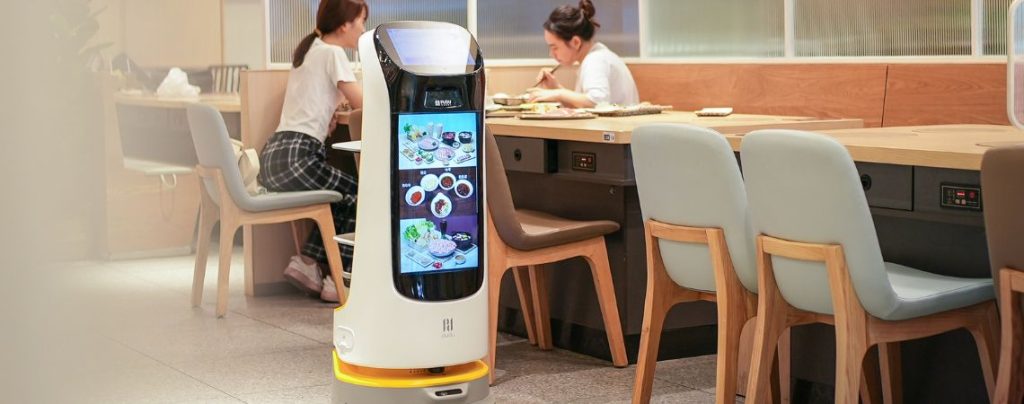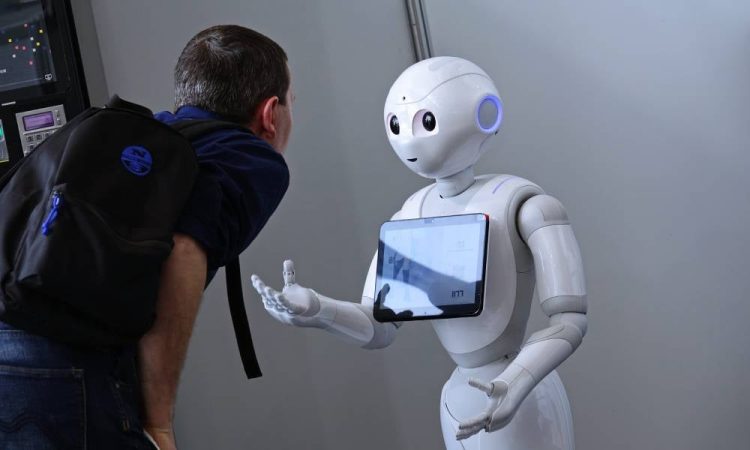1. Introduction
The service industry, which includes sectors such as hospitality, healthcare, retail, and entertainment, has traditionally relied heavily on human workers to engage with customers, provide services, and ensure smooth operations. However, with the rapid advancements in robotics and artificial intelligence (AI), a growing number of companies are integrating robots into their service offerings.
Robots are no longer confined to the factory floor; they are now increasingly part of customer-facing functions such as front-desk assistance, order taking, delivery services, and even personalized healthcare. These robots are designed to perform tasks that range from simple, repetitive jobs to more complex customer interactions, enabling businesses to improve operational efficiency, reduce labor costs, and enhance the overall customer experience.
The growing adoption of service robots is driven by several key factors:
- Technological Advancements: Robots are becoming smarter, with enhanced capabilities in AI, machine learning, computer vision, and natural language processing (NLP), allowing them to interact seamlessly with humans and perform tasks autonomously.
- Labor Shortages: The global shortage of skilled labor and the high turnover rates in certain service sectors have prompted businesses to look for alternative, efficient, and reliable solutions.
- Cost Efficiency: As robots become more affordable and energy-efficient, they present a compelling business case for companies to reduce human labor costs and increase productivity.
This paper delves into the transformative role of robots in various sectors of the service industry and examines how they are reshaping customer interactions, improving service delivery, and solving long-standing challenges.
2. Robots in the Hospitality Industry
The hospitality industry has embraced robotics as a means to improve service delivery, streamline operations, and enhance the customer experience. Robots in hotels, restaurants, and airports are performing a variety of tasks that traditionally required human employees, such as check-in/check-out, room service delivery, and concierge functions.
2.1 Robots for Customer Service in Hotels
In the hospitality sector, robots are increasingly being used to perform check-in and check-out services, welcome guests, and even deliver luggage. By automating these routine tasks, hotels are able to provide guests with quicker, more efficient services while freeing up human staff to focus on more complex customer needs.
- Robotic Concierges: Some high-end hotels, like the Henn-na Hotel in Japan, have introduced robotic concierges capable of interacting with guests, providing information, and handling basic requests. These robots are equipped with AI and NLP technologies to understand guest inquiries and respond appropriately.
- Room Service Robots: Companies such as Savioke’s Relay robot have been used to deliver items such as food, toiletries, or towels to hotel rooms. These robots can navigate hallways and elevators, delivering items with little human intervention, ensuring faster, more efficient service.
2.2 Robots in Restaurants
Restaurants are also leveraging robots to enhance customer service and reduce wait times. These robots are not only improving the efficiency of food service but also adding an element of novelty that attracts customers.
- Order-Taking Robots: Some restaurants are experimenting with robots that can take orders from customers. These robots can navigate the dining floor and use speech recognition to interact with customers, improving the ordering process and freeing up staff to focus on food preparation and delivery.
- Food Delivery Robots: Automated delivery robots are increasingly used in food service, particularly in larger establishments and high-volume restaurants. These robots can navigate restaurant floors, delivering food to customers without requiring human intervention. This allows for faster service, better customer satisfaction, and reduced human labor costs.
2.3 Challenges in the Hospitality Sector
While the hospitality industry has seen positive results from robotic integration, several challenges remain:
- Customer Acceptance: Some customers may be hesitant to interact with robots, particularly in roles that traditionally involve human interaction. Overcoming this cultural barrier and ensuring that robots do not disrupt the guest experience is a key consideration.
- Technological Limitations: Despite advancements in robotics, robots are still prone to malfunctioning, particularly in dynamic environments where unpredictable situations may arise. For example, navigating crowded hotel corridors or restaurant spaces can present challenges for robots.
- Cost of Implementation: While robots offer long-term cost savings, the initial investment in robotic systems can be substantial. Small hotels or restaurants may find it difficult to justify the cost of robotics compared to the savings they generate.

3. Robots in Healthcare: A Revolution in Patient Care
The healthcare industry is another sector where robotics is poised to make a profound impact. Robots in healthcare are being used for a variety of purposes, ranging from assisting in surgeries to providing rehabilitation and performing patient monitoring tasks. The primary aim of healthcare robots is to increase precision, improve outcomes, and reduce labor costs.
3.1 Robotic Surgery
One of the most advanced and well-known uses of robotics in healthcare is in the field of robotic surgery. Robotic systems like the da Vinci Surgical System enable surgeons to perform minimally invasive procedures with increased precision and control. These systems are equipped with specialized robotic arms and high-definition cameras, allowing surgeons to conduct operations with smaller incisions and reduced recovery times for patients.
- Precision and Accuracy: The da Vinci system, for example, allows surgeons to perform delicate procedures with greater accuracy, reducing the risk of complications.
- Minimally Invasive Procedures: Robotics enables surgeries to be performed with smaller incisions, leading to faster recovery times, reduced hospital stays, and less post-surgical pain for patients.
3.2 Robots for Rehabilitation and Assistance
Robots are also being used to assist in rehabilitation and physical therapy. Robotic exoskeletons and assistive robots can help patients with mobility impairments or injuries regain movement and function.
- Exoskeletons: Robotic exoskeletons, such as those developed by Ekso Bionics, are helping people with spinal cord injuries to walk again by providing support and facilitating movement. These devices are increasingly used in physical therapy to speed up recovery after injuries.
- Robots for Elderly Care: In many countries with aging populations, robots like the PARO seal robot and Pepper have been introduced in elder care facilities. These robots offer companionship and support, providing emotional benefits for elderly individuals who may experience loneliness or depression.
3.3 Challenges in Healthcare Robotics
While healthcare robots offer numerous benefits, there are also significant challenges:
- Regulatory Hurdles: The healthcare industry is highly regulated, and introducing new technologies like robots into clinical practice requires extensive testing and certification from health authorities, such as the FDA (Food and Drug Administration) in the United States.
- High Costs: Advanced robotic systems, particularly in surgical settings, are expensive. These costs can be a significant barrier to widespread adoption, particularly in less developed healthcare systems.
- Technological Complexity: Many healthcare robots require highly specialized programming and maintenance. Hospitals must invest in training staff and ensuring that robots are properly maintained to avoid costly malfunctions.
4. Robots in Retail: Improving Customer Experience
The retail industry has been another early adopter of robotics. Robots in retail are transforming the shopping experience, particularly in terms of customer service, inventory management, and logistics.
4.1 Robots for Customer Assistance
Retail robots can interact directly with customers, guiding them to the right products and assisting with inventory inquiries. These robots are equipped with natural language processing and AI-driven interfaces that allow them to engage with customers in a friendly and helpful manner.
- Service Robots: Robots like Pepper are being used in stores to help customers find products, answer questions, and even entertain children. They act as a bridge between the physical and digital shopping experiences, providing a unique and engaging touchpoint for consumers.
- Self-Checkout Robots: In some grocery stores, autonomous robots have replaced traditional checkout lanes. Customers scan their items using automated kiosks or mobile apps, allowing for faster, more efficient checkout without needing human cashiers.
4.2 Inventory Management and Stock Replenishment
Robots are also improving inventory management in retail stores. Robots like Bossa Nova are used to scan shelves, track product levels, and alert staff when stock is running low. This automation reduces the need for human workers to constantly check stock and ensures that inventory levels are always up to date.
- Robotic Shelf Scanning: Robots equipped with cameras and sensors can scan store shelves in real time to detect out-of-stock products, misplaced items, or price discrepancies. This helps ensure that products are always available and that pricing is accurate.
4.3 Logistics and Order Fulfillment
In addition to in-store applications, robots are increasingly being used in warehouse and fulfillment center operations to assist in order picking, packaging, and shipping. Autonomous robots are streamlining the logistics behind online retail by improving the speed and accuracy of order fulfillment.
5. Conclusion
Robotics technology is revolutionizing the service industry across a wide range of sectors, including hospitality, healthcare, retail, and beyond. Service robots are improving efficiency, reducing labor costs, and enhancing the customer experience. Although there are challenges to widespread adoption, such as regulatory barriers, high costs, and public acceptance, the future of robots in the service industry looks promising.
As robots continue to evolve with advancements in AI, computer vision, and machine learning, they will become an increasingly integral part of the service sector. In the coming years, we are likely to see even more sophisticated robots taking on complex tasks, offering personalized services, and collaborating with humans to deliver exceptional experiences to customers.
The integration of robots in the service industry is not just a technological trend but a fundamental shift in the way businesses operate. By harnessing the potential of robotics, companies can gain a competitive edge and meet the ever-growing demands of customers in the digital age.











































